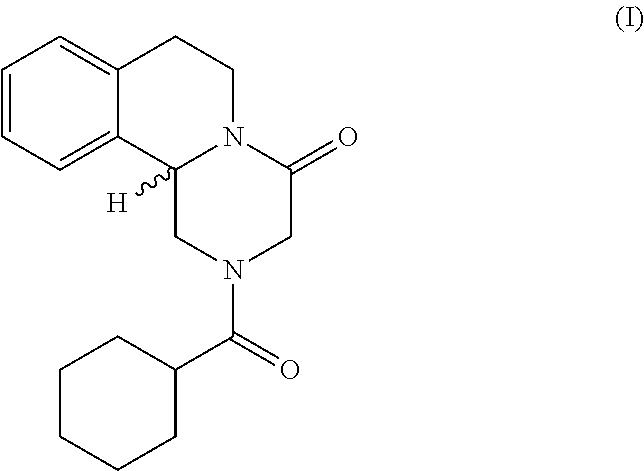Method for the production of praziquantel
a technology of praziquantel and praziquantel, which is applied in the field of praziquantel production methods, can solve the problems of low yield, laborious and costly, and acceptance problems, and achieve the effect of achieving rather low yield
- Summary
- Abstract
- Description
- Claims
- Application Information
AI Technical Summary
Benefits of technology
Problems solved by technology
Method used
Image
Examples
example 1
on of (R)-2-Cyclohexanecarbonyl-1,2,3,6,7,11b-hexahydro-pyrazino[2,1-a]isoquinolin-4-one ((R)-Praziquantel) via chiral resolution of the corresponding racemic mixture using HPLC
[0040]
[0041]Racemic Praziquantel is well separable / resolvable with preparative chromatography using numerous chiral stationary phases. High productivity could be achieved after optimization of separation conditions.
[0042]Examples of Conditions:
[0043]Stationary phase: Chiralpak AD (20 μm)
[0044]Wave length: 230 nm
[0045]Eluent: Methanol
[0046]Stationary phase: Chiralpak ID (20 μm)
[0047]Wave length: 230 nm
[0048]Eluent: Acetonitrile / Methanol
[0049]Stationary phase: Chiralpak IA or IC (20 μm)
[0050]Wave length: 230 nm
[0051]Eluent Methanol / Dichloromethane
example 2
ion of (S)-Praziquantel
[0052]8.94 g (79.7 mmol) of potassium tert.-butoxide are dissolved under stirring in 150 mL dry THF under inert atmosphere (oxygen and moisture excluded). After cooling down to −10° C. a solution of 50 g (159.4 mmol) of (S)-Praziquantel (HPLC-purity 99.6%, ee=98.2% (S)) in 130 mL dry THF is dropwise added keeping the temperature lower than −7° C. After 4 h stirring at −10° C. the mixture is poured into an ice cold solution of 27 g (449.6 mmol) acetic acid in 300 mL deionized water. After stirring for further 30 min while leaving the solution warming up slowly to room temperature, 250 mL dichloromethane are added, the phases are separated and the aqueous layer is extracted two times with 150 mL dichloromethane. The combined organic layers are then washed with water and dried over sodium sulfate. After filtration and evaporation, 45.75 g (146.4 mmol) of a light orange crystalline residue are isolated and characterized as racemic Praziquantel (92% of theory, HPLC...
example 3
ion of (S)-Praziquantel Using Different Reaction Conditions
[0053]Table 1 exemplarily shows some results obtainable in the racemization of (S)-Praziquantel under different reaction conditions.
TABLE 1StartingTemperatureTimeMaterialSolventBase(° C.)(min)Result(S)-PZQTHFKOtBu−25225(S)-PZQ 83%99%0.7 eq(R)-PZQ 16%Impurities 1%(S)-PZQTHFKOtBuRT220(S)-PZQ 29%99%0.7 eq(R)-PZQ 34%Impurities 36%(S)-PZQTHFKOtBu−15180(S)-PZQ 71%99%0.7 eq(R)-PZQ 27%Impurities 2%(S)-PZQTHF +KOtBu−15165(S)-PZQ 50%99%0.5 eq0.8 eq(R)-PZQ 47%DMSOImpurities 3%
PUM
| Property | Measurement | Unit |
|---|---|---|
| temperature | aaaaa | aaaaa |
| temperature | aaaaa | aaaaa |
| optical purity | aaaaa | aaaaa |
Abstract
Description
Claims
Application Information
 Login to View More
Login to View More - R&D
- Intellectual Property
- Life Sciences
- Materials
- Tech Scout
- Unparalleled Data Quality
- Higher Quality Content
- 60% Fewer Hallucinations
Browse by: Latest US Patents, China's latest patents, Technical Efficacy Thesaurus, Application Domain, Technology Topic, Popular Technical Reports.
© 2025 PatSnap. All rights reserved.Legal|Privacy policy|Modern Slavery Act Transparency Statement|Sitemap|About US| Contact US: help@patsnap.com



